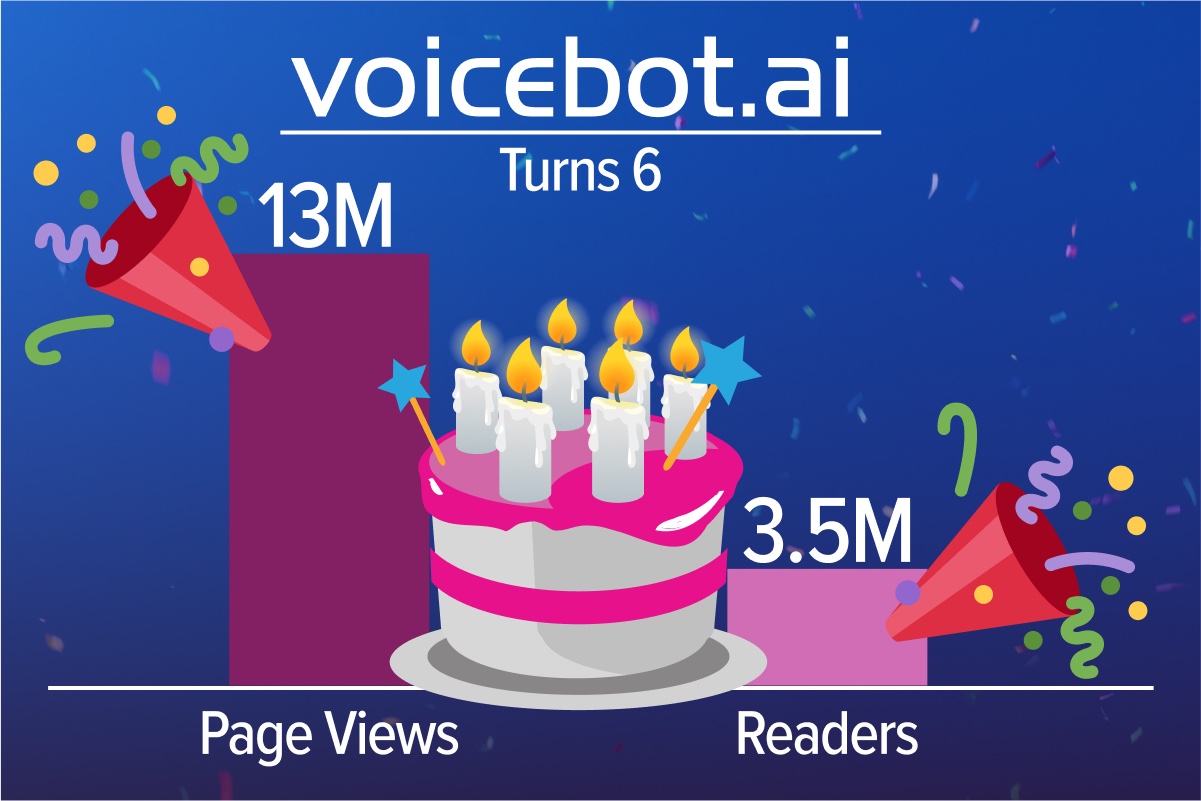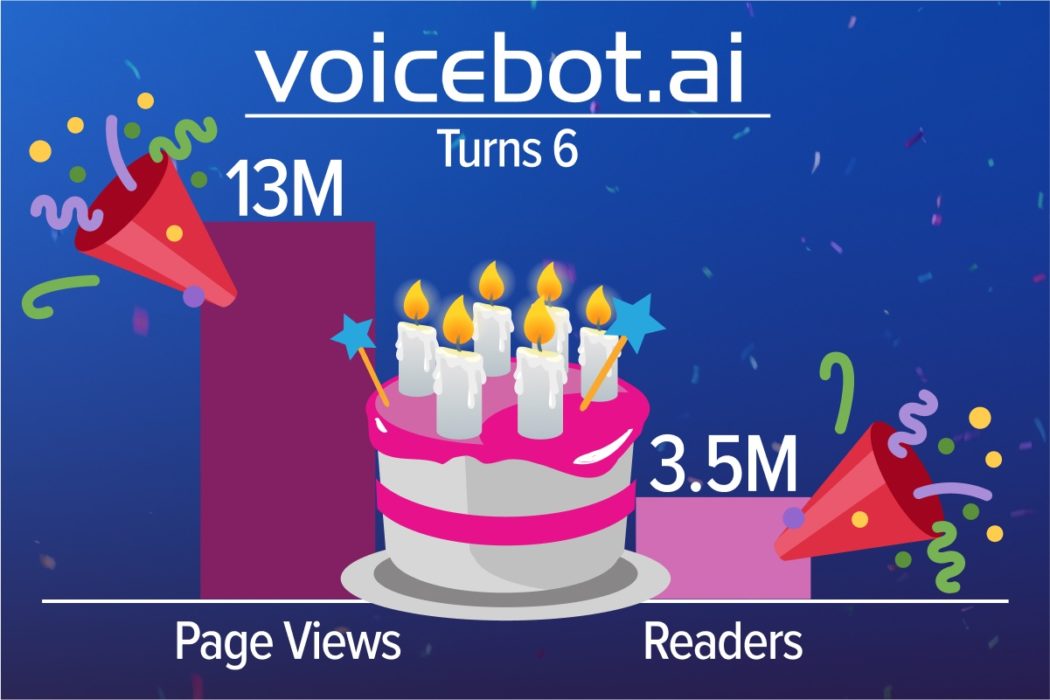Voicebot is 6 Years Old – Here are 6 Ways the Industry Has Changed

Voicebot.ai began publishing news on September 15, 2016. Since that time, we have published more than 4,500 articles read by over 3.5 million unique users. Total pageviews topped 13 million earlier this year. We also have published over 300 hours of in-depth interviews over the course of 270+ podcasts with industry leaders that landed hundreds of thousands of downloads. Our reports have been downloaded more than 50,000 times.
Needless to say, we have seen a lot of news, innovation, data, and change over the past six years. We are pleased that Voicebot.ai has reached so many people, but the more interesting aspect of those metrics is the story they tell. It has been an honor to watch that story unfold and share it with you.
What Has Changed?
We just returned from the industry’s largest annual conference, Voice Summit 2022. I had the opportunity to reconnect with many industry leaders and get their take on how things have changed. You can get a flavor for those conversations in two recent Voicebot Podcasts that include a dozen interviews from the conference floor of Voice Summit (Part 1, Part 2).
The conversations, our evolving news coverage, and the shift in topics characterized by those metrics above offer insight into where the industry is today and where it is headed. Here are six changes that distinguish the voice and conversational AI industry in 2022 from the earlier era.
- Rise of the enterprise use cases – Six years ago, nearly all of the industry talk and momentum focused on consumer use cases. Today, our coverage and the activity at Voice Summit reflect a shift to more enterprise use cases. This means less focus on Alexa and Google Assistant and more on custom conversational AI solutions. Some of those are solutions are for employees, and many connect directly with customers through support and products.
- Custom is hot – You can see in the news and industry announcements that custom conversational AI solutions are an area of strong growth. This trend includes custom voice assistants along with customized deployments of conversational AI technology. A lot of companies are deploying custom solutions, whereas off-the-shelf and easy-to-implement templated implementations have been more popular for much of the past six years. Enterprises now know that generic implementations offer limited benefits. However, those implementations enabled business users to better understand the technology, their requirements, and what benefits could be captured.
- Technology continues to improve – Conversational AI technology, and voice AI, in particular, were improving rapidly in 2016 and already very good by 2019. However, the drive for custom solutions has required even better automated speech recognition, natural language understanding, and dialogue management. The industry has delivered. Word error rates are down, and NLU performance is up.
- Less focus on devices – Our early coverage was heavily focused heavily on devices. That was a reflection of the consumer orientation of the market and the fact that many of these devices were truly novel. They were newsworthy, and everyone was reflecting on whether they would be adopted and how they would be employed. Many of these devices today are mature and widely adopted, and the popular use cases are clear. The focus has shifted to new applications. This, in turn, has lowered the profile of Amazon and Google, who once drove a far greater proportion of industry activity.
- New applications abound – Conversation AI is a driving force behind the rise of an entirely new industry: synthetic media. The solutions range from technologies everyone will recognize as part of the voice industry, such as synthetic voices, to virtual humans and text-to-x solutions for text, image, and video creation. Natural language inputs are being employed for conversational interactions and so systems can better understand our intents before completing a complex task. You wanted multimodal. You have an industry entirely built on multimodal conversational interactions. Synthetic media is automating content generation and its adoption is growing fast. It reflects a significant expansion of the voice industry’s total addressable market.
- We are living in 2025 – The biggest change that hit the industry is clearly the pandemic and its aftermath. In some cases, the pandemic accelerated the rise of new applications and new customer needs. Greg Cross, CEO of Soul Machines, sums it up well by saying, “We are living in 2025.” It may be 2022, but the adoption of new behaviors has led to new patterns of technology adoption that would have taken several more years to play out. The residual effects will drive the industry’s activities over the next six years.
What About the Winter?
I am often asked about the voice winter. People equate this term to the much-discussed AI winters when investment and interest waned and then re-emerged over several decades in a repeating cycle. My response is typically to ask, “What segment of the market are you referring to?” The custom market is much larger than it used to be. The enterprise segment is showing strong growth. Granted, the enterprise market is also very competitive. There is significant revenue to be had, but there are many companies vying for it. That often means the growth doesn’t seem strong because it is dispersed among so many providers.
A slowdown has come in the consumer market. The Amazon and Google effect around consumer voice assistants has lost momentum. It can pick up again with a new round of novel application innovation, but the market that was driven by the emergence of smart devices is now mature. Synthetic media contains examples of new applications that can become a catalyst for renewed growth. However, there are also many new applications that will emerge from traditional conversational AI sources.
What Has Not Changed
As much as the industry has changed, many things have not. There is a lot of news. Companies are bringing out new technology and applications, securing funding rounds, and landing new customers every week. A lot of people continue to read, listen to, and watch the coverage and analysis provided by Voicebot.ai.
One other thing that hasn’t changed is Voicebot’s mission. As much as the metrics included above are nice to look at, they were never one of our objectives but instead have served as an industry barometer. Our mission from day one:
Voicebot.ai was created to provide high quality coverage of the voice and conversational AI industry that includes depth, nuance, and fact-based analysis to keep you informed and help you make better decisions.
Voicebot.ai doesn’t exist without our community of readers, listeners, and report subscribers. Thank you for your support over the years. It’s been an honor to serve the industry and become the most cited source for news and analysis. It has been even more rewarding to organically build the largest community in the voice and conversational AI industry and pick up a long list of friends along the way. Thanks for joining us on the journey.
Follow @bretkinsella Follow @voicebotai
The Rise and Stall of the U.S. Smart Speaker Market – New Report









